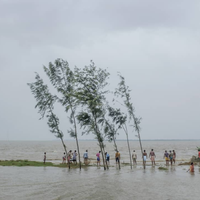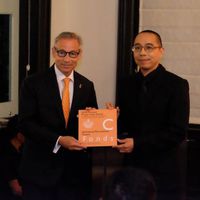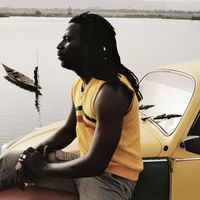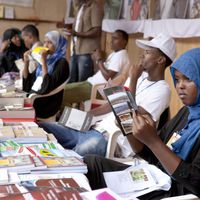Triangle Conference | sustaining the global art ecologies through networking

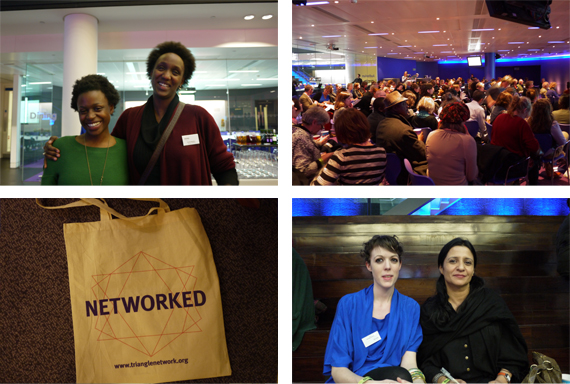
30 years ago, the Triangle Network started instinctively and spontaneously, perhaps like an artistic process. In the beginning, artists Anthony Caro and Robert Loder were looking for a space to store their artworks in Northeast America. The storage space was found and eventually turned into a platform for sharing and exchange among artists in the area and beyond. Through specific needs and a sense of commitment from various individuals, the network expanded and materialized. Three decades later, the Triangle Network is a true global network of artist-run spaces that aims to sustain informal environments and enable learning through experimental workshops and events. This non-hierarchical network model focuses on art as an artistic process rather than a “commercial product” for the art market, and it is about connecting people rather than generating money. It is about the art communities and the possibilities for sustaining them through shared visions and values.
About the Triangle Conference
The Triangle Conference, which took place on November 26th and 27th 2011 in London, marked the 30th anniversary of the Network’s founding. By and large the 2-day conference focused on the very raison d’être of art networks, their assets, as well as their current struggle for survival. Through presentations and panel discussions, questions were raised to identify the true role of art networks, and how they can be used for professional development or community building. What can art networks do for artist’s rights and freedom of expression? How do they push boundaries and create new content? What are the differences between art networks and institutional structures? Where do art networks position themselves within the art world?
[caption id="attachment_18933" align="alignnone" width="570"]
 Triangle workshop[/caption]
Triangle workshop[/caption]The Assets
Through workshops, art networks provide learning models that are different from institutional frameworks. As such they enable collective experiences that enhance the public’s appreciation for the arts. They also act as binders for communities who are seeking opportunities, resources, and knowledge.
Networks have a diversity of approaches that mostly operate at a micro level yet when put together have the stunning ability to form a global perspective on art and creativity. Unlike the commercial art world, art networks can transcend a number of barriers because they apply a horizontal framework that puts artists on equal grounds regardless of their origins, social or educational background. The volume of content produced through art networks is significant but perhaps currently not thoroughly documented and recorded.
"This is a non-hierarchical network with no more centre and periphery. It is about sharing things together, through dialogues and as part of a global network that is based on the notion of art ecology" - Alessio Antoniolli, the network coordinator.
The international dimension of the Triangle Network has enabled multi-lateral cooperation between various organizations. They have been useful in the process of identifying funding sources, and providing support to emerging artists and institutions that do not meet the criteria set by larger international organizations such as UNESCO.
[caption id="attachment_18944" align="alignnone" width="570"]
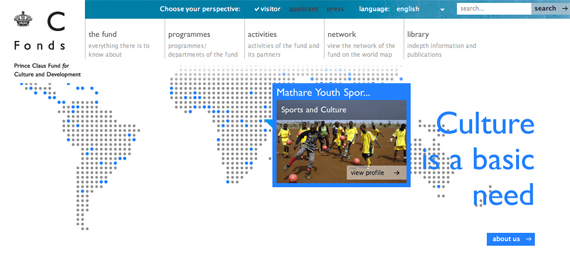 Prince Claus Foundation website[/caption]
Prince Claus Foundation website[/caption]Since its founding 15 years ago, the Dutch foundation Prince Claus has been supporting small organizations and individual artists without necessarily going through governments and UN bodies.
“The Prince Claus Foundation is a firm believer that culture is a motor for development and change and we consider that culture is a basic need. The Fund is first and foremost a family, a network, and then a fund. Its open network grows on a daily basis due to the number of people who engage in support activities by providing expertise, knowledge, and resources to the network. The network is based on mutual respect and it is about shared vision and common inspiration.” – Christa Meindersma of the Prince Claus.
Through its Network Partnerships Programme, the Prince Claus has generated a network within a network by gathering sub-regional networks from around the world, in order “to connect, share, and become a family of minds, a place of recognition.” (Davide Quadrio, Arthub Asia) This organic structure leads toward the development and sustainable balance that are required to generate environments for creative minds. Current network partners include the Southasian Trust, Drik Picture Library in Bangladesh, Supersudaca Architecture in the Netherlands, and Komunitas Salihara Arts Center in Indonesia, among others.
Time for reflection and renewal
In her presentation on the “Principles and Ethics that Guide Cultural Networks” Mary Ann DeVlieg clearly set the tone by referring to the existential struggle facing art networks as they are standing in between the desire to remain informal by operating as “chaotic structures” and on the other hand their need to become stronger business models in order to professionalize themselves and be self-sustained.
While some art individuals hold on to an idealistic paradigm in which art networks are less dependent on money, others highlighted that it may be time to seek new perspectives and models that breach idealistic ways of thinking about the arts. Project evaluation, self-evaluation for artists, better strategies, and a clear understanding about the value of art and culture in the 21st century, along with their benefits and processes are crucial elements to consider in the future.
This time of crisis might also be a time for opportunity and change. The uncertainty of the current global economic crisis and its repercussions on not-for-profit organizations led to conversations about the evolving patterns of art funding – a pattern which has, for the longest time, revolved around a Western model characterized by a North-South dependence in the field of contemporary arts.
The scarcity of institutional funding has more recently led to new models such as online crowdfunding. The participatory and open nature of crowdfunding has made art more accessible and less institutionalized. This new possibility leaves certain people skeptical, as they suspect a lack of credibility and quality in the selection and elimination process. Yet, as Mike Troughton, founder of the WeFund crowdfunding platform mentioned during the conference, it might be time “to accept and get over it”.
Art networks and social justice
[caption id="attachment_18940" align="alignnone" width="570"]
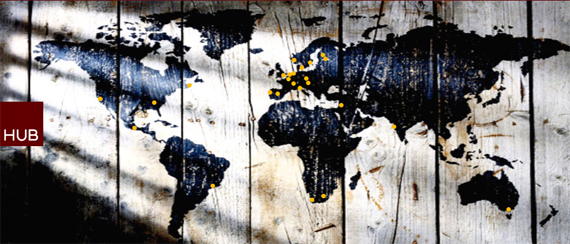 The Hub is a global community of people working to tacke the world's most pressing issues.[/caption]
The Hub is a global community of people working to tacke the world's most pressing issues.[/caption]The position of art and artists within the “real world” and in relationship to social justice was also in the debate. Jonathan Robinson of social enterprise network The Hub asked whether artists are trying enough to understand the broader context and turn art into a form of political resistance. He asked: for whom are artists practicing in the 21st century? How can they bring social transformations through their work?
The challenge of designing environments for innovation, for networks, is not, in my opinion, about designing occasional hub-like spaces (…) we need schools, youth clubs, hospitals, airport lounges, prisons, bus stops… We need spaces to be designed with one thing in mind: how to bring people together to actually remake, re-imagine, re-design, and re-build the established order. - Jonathan Robinson of The Hub on how to design environments for innovation.
[caption id="attachment_18948" align="alignnone" width="570"]
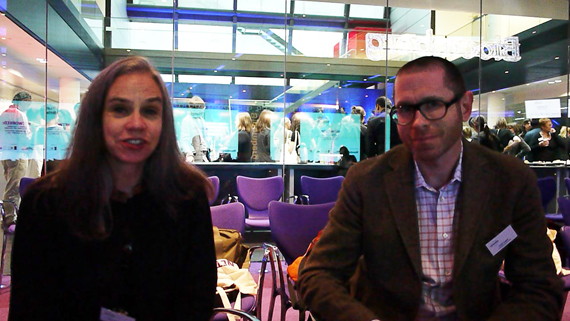 Mary Ann DeVlieg and Todd Lester[/caption]
Mary Ann DeVlieg and Todd Lester[/caption]Todd Lester of freeDimensional and Mary Ann DeVlieg, Secretary General of IETM (International Network of Contemporary Performing Arts) have joined forces to launch and run the Creative Resistance Fund, an initiative at the intersection of art for social change. This is another area where art networks have proven to be very effective: helping artists who are in danger by finding vacant apartments and bedrooms available in artist’s residencies.
“It is difficult to collaborate unless we understand the social, political, economic (implications), as well as working conditions and the contexts in which people are working. We must also ensure that working conditions for artists can be more equal, so there is a conscience there and a sense of mutual support.” - Todd Lester and Mary Ann DeVlieg on art for social justice.
“Half of (our partners) are art networks such as Asia Art Network, Arterial Network, IETM, and the others are human rights organizations. Even if the working methods are extremely different we could have quite a lot to do together to raise people’s awareness about the art sector and what they can do, provide support, and inform the human rights sector about artist’s needs.” – Mary Ann DeVlieg on the International Coalition for Arts, Human Rights, and Social Justice (ICAHS)
[caption id="attachment_18942" align="alignnone" width="570"]
 freeDimensional supports culture in the service of free expression, social justice, and equality.[/caption]
freeDimensional supports culture in the service of free expression, social justice, and equality.[/caption]An art world in transition and the reversing of old tendencies
The rising powers in Asia are in the process of reversing old tendencies in the field of contemporary art. While Europe remains an important funding source and expertise for many developing countries, many questions are raised. “Will China ever play a role in saving weakening Western institutions?” was asked by an audience member. The shifting hierarchy among countries and the evolving dynamics between Asia and Europe are shaping new patterns.
While in Europe concerns are focused on future funding sources and the sustainability of its cultural ecosystem during this time of crisis, in Asia it is about building missing bridges and forming positive perceptions on art and culture. The sheer size of this rapidly changing and culturally diverse continent means that there are opportunities yet also challenges to overcome.
In Asia, artists do not receive much support from their government, except in Japan, Korea, and Taiwan where art is in some way used to build the image of a country and for cultural diplomacy (e.g. soft power.) Asia is a sort of laboratory in which civil society acts as a counter balance to a more political agenda. - Tay Tong of Arts Network Asia.
The conference also gave the audience reminders that contemporary art remains a luxury in many countries, as it is not widely accessible, and not yet perceived as a basic need.
The Vasl Artists Collective in Karachi, Pakistan, wants to facilitate processes and support young artists in an environment that does not easily accommodate artists. It has a gallery space, organizes international exchanges and curatorial programmes that promote art from Bangladesh to the world. - Adeela Suleman and Gemma Sharpe, coordinators at Vasl Artists Collective.
Art remains difficult to access, yet it can also help to achieve principles of sustainability, as a shaper of community life and as a ground for cultural eco-systems. It can also serve as a bridge that connects minority groups who are living in remote areas, enabling links between artists (e.g. from local to global), and enhancing environments.
Ruangrupa in Jakarta, Indonesia, sometimes works with villagers in remote areas to re-introduce art in a different context and re-connect it with people who are not necessarily from the art world. Local context is important to consider, and our projects always start with the subject or content, it is about social practices and issues, and we want to make art accessible to many. - Ade Darmawan, Director and co-founder of Ruangrupa
Looking beyond

The world is in a state of transition, and it is strongly reflected throughout the global art community. The shifting balance within a multi-polar world, the democratization of media and increased access to information technology are affecting the way artists work and collaborate. In parallel, art networks, as informal structures, are the alternative channels through which artists produce work around the world: by embracing principles of sustainability, ethical practices, social justice, openness, and shared experiences rather than institutional validation and commercial successes. Their goal is to enable global connections, shape local experiences at a micro-level while involving people from nearby communities, and to use art practices as a binding tool that can generate inspiring environments to live and work in.
Lack of funding seems to be a constant issue, and it represents both a threat and an opportunity for change. Ultimately, the added value and assets of art networks should be highlighted concretely and within multiple contexts, in other words beyond the art world, in order to better demonstrate the role of art toward social and cultural development.
Sali Sasaki is the Asia Editor of culture360.org
Images: Sali Sasaki, Triangle Network, Prince Claus, freeDimensional, and The Hub.
Similar content
deadline
31 Jul 2020
deadline
14 Jun 2019
posted on
06 Oct 2017
By Kerrine Goh
08 Mar 2012
deadline
10 Feb 2020
posted on
07 Apr 2010


